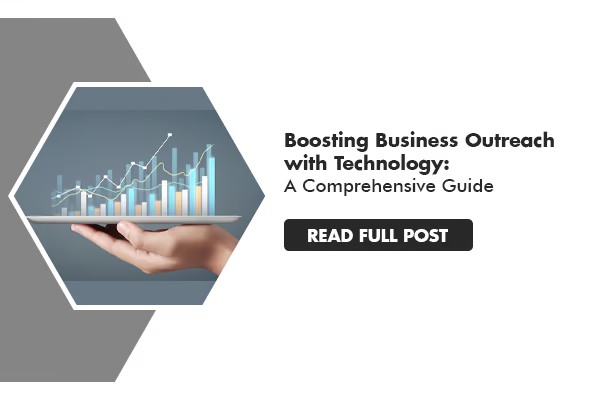In an increasingly digital world, one question every business must ask is: Are we truly reaching our full audience potential? In an age where technology is constantly evolving, it’s crucial to tap into the tools that can extend your business’s reach beyond traditional boundaries. Whether you’re a small startup or an established enterprise, leveraging technology is key to broadening your audience, strengthening relationships with customers, and driving growth.
This comprehensive guide will explore how modern technologies—from artificial intelligence to social media platforms—can dramatically boost your business outreach, ensuring that your products, services, and messages reach the right audience at the right time.
The Role of Data Analytics in Identifying Target Audiences
Before you can boost outreach, you need to understand who you’re trying to reach. Technology has made it easier than ever to identify and analyze your ideal audience through data analytics. By examining customer behavior, interaction patterns, businesses can segment their audience and tailor their outreach accordingly. For instance, data analytics can help you answer some key questions:
- Who is most interested in your products or services?
- What are their demographics, interests, and online behaviors?
- Where are they located, and what platforms are they using?
These insights allow you to focus on the customers who are most likely to convert, rather than taking a broad, untargeted approach. As a result, businesses can craft personalized messages, offers, and campaigns that resonate more effectively, enhancing engagement and conversion rates.
Expanding Reach with Social Media and Digital Platforms
Social media is one of the most powerful tools in the digital era for extending your business’s reach. These platforms enable businesses to interact with a global audience in real-time, sharing content, updates and offers to engage customers and build brand awareness.
However, the key to maximizing social media outreach lies in effective strategy:
Content Optimization: Regularly sharing content tailored to your audience’s interests—be it blogs, videos, or infographics—helps maintain engagement. Using tools such as social media schedulers can streamline the posting process, ensuring consistent visibility without overwhelming your team.
Targeted Advertising: Social media platforms offer sophisticated targeting features that allow you to display ads based on user demographics, interests, and online behaviors. This helps ensure that your outreach efforts are reaching the right people, cutting down on wasted ad spend while boosting return on investment (ROI).
Influencer Partnerships: Collaborating with influencers who align with your brand can significantly increase your reach. These influencers have built trust with their audiences, and a recommendation from them can introduce your business to new potential customers more organically than traditional advertising methods.
Automation Tools for Scaling Outreach Efforts
Manual outreach is not only time-consuming but also limits the scale at which you can connect with your audience. Fortunately, automation tools have revolutionized business outreach, allowing you to engage customers on a much larger scale without compromising personalization.
Here are a few automation solutions to consider:
Email Marketing Automation: Platforms like email marketing software enable businesses to send personalized emails to segmented lists, triggered by customer behavior (such as visiting a website, abandoning a cart, or signing up for a newsletter). Automated email campaigns can keep your brand top-of-mind for potential customers and drive conversions with targeted offers and content.
Chatbots: These AI-powered assistants can engage with customers 24/7, answering queries, offering recommendations, or guiding them through the purchase process. They provide instant support, which enhances user experience while allowing your team to focus on higher-priority tasks.
CRM Systems: CRM systems store detailed information on every customer interaction, helping businesses automate follow-up communications, manage leads, and maintain strong relationships with existing customers. These platforms allow for targeted outreach, tailored offers, and better customer retention.
The Power of AI in Personalized Customer Engagement
Personalization is at the heart of successful business outreach, and artificial intelligence (AI) is a key enabler of this trend. By using AI-powered tools, businesses can analyze vast amounts of data to deliver highly personalized experiences that resonate with individual customers.
For instance, AI can power:
Recommendation Engines: These systems analyze customer behavior to recommend products or services they’re most likely to be interested in, boosting engagement and increasing sales.
Predictive Analytics: AI can predict customer preferences and behaviors based on past interactions, allowing businesses to proactively tailor their outreach strategies to meet customer needs.
Natural Language Processing (NLP): AI-driven NLP enables chatbots and virtual assistants to have more human-like interactions with customers, improving customer support and engagement.
By integrating AI into your business outreach strategy, you can create more personalized customer experiences that drive loyalty and growth.
Leveraging Video and Visual Content to Capture Attention
In today’s content-driven world, visual media—especially video—has become a cornerstone of effective business outreach. Studies show that video content is far more engaging than text, with consumers being more likely to watch a short video than read through an article or blog post. This presents a significant opportunity for businesses to capture attention and memorably convey messages.
Here’s how to leverage visual content for outreach:
- Product Demos and Tutorials: Showing how your product works in action can help potential customers better understand its value.
- Customer Testimonials: Authentic video testimonials from satisfied customers build trust and credibility, encouraging new prospects to consider your offerings.
- Live Streaming: Hosting live events or Q&A sessions can foster real-time interaction with your audience, increasing engagement and boosting brand loyalty.
As visual content becomes increasingly popular across social media and websites, creating engaging videos and infographics should be a key component of your outreach strategy.
Here are some key areas to focus on:
Search Engine Optimization (SEO): By optimizing your website for search engines, you increase your chances of ranking higher in search results, which in turn drives organic traffic. Effective SEO involves using the right keywords, meta descriptions, and backlinks to improve your site’s visibility to potential customers.
Mobile Responsiveness: With mobile users making up a significant portion of internet traffic, having a mobile-optimized website ensures a seamless experience across devices. A responsive design can help retain visitors and encourage them to engage further with your business.
Content Marketing: Your website should feature high-quality, informative content that speaks to the needs and interests of your audience. Whether it’s through blog posts, whitepapers, or case studies, content marketing can attract visitors and establish your brand as a trusted authority in your field.
Conclusion
Technology has fundamentally reshaped the way businesses approach outreach, offering a wide array of tools that enhance communication, personalize engagement, and measure success. From data analytics and AI to social media and automation, the possibilities for expanding your reach and connecting with new audiences are virtually limitless.
To stay competitive, businesses must embrace these technologies and integrate them into their outreach strategies. By doing so, you can build stronger relationships, drive growth, and ensure your business is well-positioned for the future.




